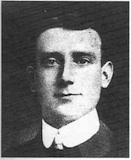
By Jim Kemmy
‘The two murdered mayors’, is still a familiar Limerick expression, particularly among older citizens. George Clancy was elected as Mayor of Limerick in January 1921 and Michael O’Callaghan had served in that office in the previous year. Both men were killed by British military forces in the small hours of Monday 7 March 1921.
George Clancy was born in Grange, County Limerick. He was educated in the local school and at St. Patrick’s Seminary, Bruff. His family were strongly nationalist and his father had been a Fenian supporter. His grandfather was also named George and he imbued the eager young student with a love of the Irish language and learning. George worked hard to become a fluent Irish speaker and a notable Gaelic scholar.
In 1899 Clancy left for Dublin to enter University College. He became a mem- ber of the Celtic Literary Society and Arthur Griffin and other prominent nationalists were among his fellow members. He naturally gravitated to the Gaelic League and immediately came under the influence of Patrick Pearse, one of the League’s teachers. He also joined the Gaelic Athletic Association at this time.
One of Clancy’s friends at the university was the writerJames Joyce, who based the character Davin, the young nationalist and ‘peasant scholar,’ in his book ‘Portrait of the Art as a Young Man’ on his Limerick fellow student. Kate O’Brien, in her book ‘My Ireland’ quotesJoyce’s biographer, Richard Ellman, who stated that, “according to Joyce, George Clancy was the only one among his friends at university who called him James; and there appears to have been a special vein of gentleness and respect in [his] feeling for this young dreamer from Limerick.”
In 1904 George Clancy graduated and secured a teaching post at the Jesuit College at Clongowes Wood. He was never robust and ill-health -- which was to continue to blight his life -- forced him to relinquish this employment and to return to Grange. But he did not rest for long and was soon in the thick of nationalist activities. He started Irish classes and organised a variety of Gaelic functions. In 1906 he led the agitation to divide up the de Salle Estate, near his home, among small farmers and this campaign culminated successfully in a large public meeting at Grange in September 1906.
In October 1908 Clancy came to Limerick City to teach Irish. On most evenings he was engaged in the promotion of nationalist activities at the Gaelic League headquarters in Thomas Street. With other members of the League, he was a frequent visitor to Colaiste na Mumhan at Ballingeary, Co. Cork. There he met and later, in July 1915, married Maire Killeen, a Limerick national teacher, who shared all his interests in Irish culture.
As the pace of nationalism quickened in the early years of the twentieth century, George Clancy joined the Irish Volunteers in Limerick, on 13 December 1913, when the movement was founded in the city, having earlier played a part, with Sean Heuston and others, in the formation of Fianna Eireann (Irish Boy Scouts). After the 1916 Rising the leaders of the volunteers were kept under constant surveillance by the authorities and many of them were arrested. Clancy was among those arrested and he was imprisoned in Cork. The prisoners went on hunger strike and were released before they could be brought to trial. He returned to Limerick and continued to teach. Much of the work of organising the local military activities was undertaken by him, as most of the leaders were in prison. The burden of constant overwork greatly taxed his health. After a bad bout of influenza, he had to give up teaching and he then found employment with the National Assurance Company.
He contested the 1920 local elections and became an alderman for the city. He was unanimously elected as Mayor of Limerick in the following year. At that time regular night raids were made by the military on the homes of active nationalists. The Mayor was no exception to this rule. George Clancy was duly arrested and, when released, realised that it would not be safe for him to continue to sleep in his own house.
The Clancy family lived at Castleview Gardens, Thomondgate. On Sunday 6 March 1921 the mayor had attended the funeral of his father-in-law. That night he retired to bed before midnight and was reading a book in bed. His wife was in an adjoining room, comforting her bereaved mother. In the early hours of the morning, the Clancy family was awakened by a loud banging on the door. George opened the door himself, against the advice of his wife. He was confronted by three armed men who ordered him out of his house. When he refused to obey this order, one of the men stepped forward and fired. His distracted wife made a brave attempt to save her husband and was herself wounded by a bullet in the wrist. The bullets found their mark and the mayor lay dead.
![[Irish Republican News]](https://republican-news.org/graphics/title_gifs/rn.gif)
![[Irish Republican News]](https://republican-news.org/graphics/title_gifs/harp.gif)

